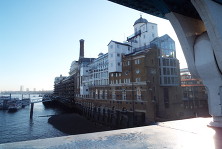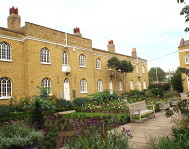








Oliver Goldsmith in Peckham
Oliver Goldsmith’s time living in Peckham is commemorated today by a road, a small pocket-size park, a school and a housing estate all named after him. His stay in Peckham was not for long and it is not exactly clear when this was but probably some time around 1756. He was of course to go on to great literary achievement and acclaim with works that included the play She Stoops to Conquer and the novel The Vicar of Wakefield.
After graduating in 1750 from Trinity College Dublin, Goldsmith went on to study medicine, firstly at Edinburgh and then in Lieden, and then undertook a tour of Flanders, France, Switzerland, Germany and Italy, travelling on foot. In 1756, aged 25, he returned to London with no career and no means of support as his uncle who had supported him during his studies had died. A friend he had made whilst studying in Edinburgh arranged a temporary post for Goldsmith as an usher at a Presbyterian boys’ school in Peckham. The school was run by the friend’s father, Dr Milner, and situated in Meeting House Lane.
An usher was the equivalent of a teaching assistant and, according to Goldsmith, his lot was not a happy one. He wrote later: “The usher is generally the laughing-stock of the school. Every trick is played upon him; the oddity of his manners, his dress or his language, is a fund of eternal ridicule; the master himself now and then cannot avoid joining in the laugh; and the poor wretch, resenting this ill-usage, lives in a state of war with all the family.” He hid his resentment well for the youngest of Dr Milner’s ten daughters, Hester, was to recall he was “very good natured; he played all kinds of tricks on the servants and the boys, of which he had no lack in return; told interesting stories; was remarkably cheerful, both in the family and with the young gentlemen of the school, and amused everybody with this flute.”
In the long term, his stay in Peckham was to lead to better things for it was at the table of Dr Milner that he met Mr Griffiths, the proprietor of the “Monthly Review”. Mr Griffiths was impressed by Goldsmith’s talents, and engaged him to work as a contributor to the “Monthly Review” for a small salary and board and lodging in Mr Griffiths’ home in Paternoster Row. So Goldsmith left Peckham and took the first step on his literary career. After he had achieved fame and success, Dr Milner's school became known as Goldsmith's House.
The house was demolished in 1876 as together with the grounds it had been purchased by the Sanitary Dwellings Company where artisan’s dwellings were built, named the Goldsmith Residences. The London Schools Board opened a school in Peckham Road in 1900 and whilst the original intention was to name it the Peckham Road School, it was named the Oliver Goldsmith School when it opened. There is a blue plaque commemorating Goldsmith mounted on the school’s wall.
Web discoveries
- UK Casino Not On Gamstop
- UK Casino Not On Gamstop
- Non Gamstop Casino
- Casinos Not On Gamstop
- Non Gamstop Casinos
- Non Gamstop Casinos
- Non Gamstop Casino
- Casino Sites Not On Gamstop
- Slots Not On Gamstop
- Casinos Not On Gamstop
- UK Betting Sites Not On Gamstop
- UK Casino Not On Gamstop
- Best Non Gamstop Casinos
- Betting Sites
- Non Gamstop Casino Sites UK
- Best Non Gamstop Casinos
- Non Gamstop Casino
- Casinos Not On Gamstop
- Non Gamstop Casino Sites UK